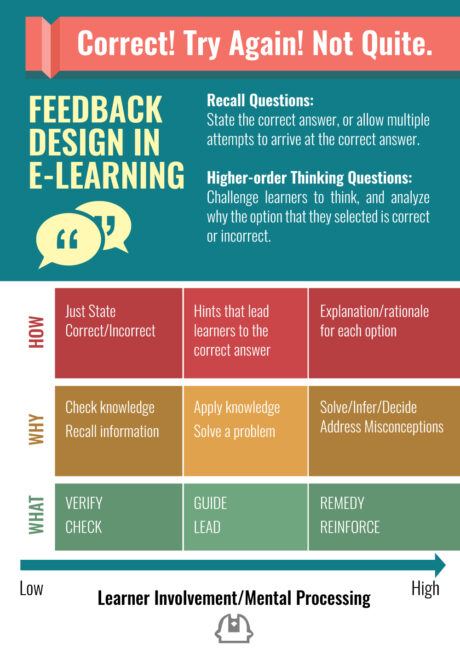
“Feedbacks (sic) must be enhanced.”
This was a comment that I received from a Reviewer on a storyboard that I scripted when I began freelancing. Since the comment was ambiguous, I decided to ask for specifics. But, all I got was, “As per our standards, we write something more than Correct/Incorrect”. The response didn’t surprise me because “standards” is the oft-quoted reason for many a comment that Instructional Design reviewers raise during a review.
But why do we have these standards? From where are these derived? Is there a pedagogical principle to this? This piece is an attempt to answer these questions, and analyze the concept of Feedback from a learning standpoint.
Relevance
Learning evaluation may take either of the two forms – Formative (Check Your Understanding; Quick Quiz and so on) or Summative (Final Assessment). Formative Assessment is usually part of the learning process. The purpose is not to score or evaluate, but provide opportunities for learners to check their understanding, and rectify any misconceptions. On the other hand, Summative Assessment is meant to score/evaluate learners. The concept of feedback is mostly associated with the former – that is Formative Assessment. Given that this type of assessment is meant to facilitate learning (and not keep score), feedback must be designed keeping this in mind.
Purpose
As mentioned, the purpose of feedback in Formative Assessment is to assist learners in the learning process. As such, it may be designed to supply the correct answer to learners, lead them to the correct answer, or make them think through their selection – reaffirm, if correct, and remedy if incorrect.
Design
The feedback design in Formative Assessment should be driven by the question type. If the question is designed to test recall, then you may either supply the correct answer or allow multiple attempts to arrive at the correct answer. This feedback style does not call for any sort of mental processing by learners – information is just stated in response to the selection that learners make.
On the other hand, if the question is designed to test higher-order thinking (apply, solve, analyze, and so on), it is better to design feedback that will challenge learners to think and understand why the option that they selected is correct or incorrect. This feedback style calls for mental processing by learners – learners have to analyze and/or understand the information that is displayed as part of feedback.
To sum up, feedback design may take any one of these forms.
And of course, feedback accompanies interaction – so here is a short video on interactivity in learning.


0 responses on "Feedback Design in E-Learning"